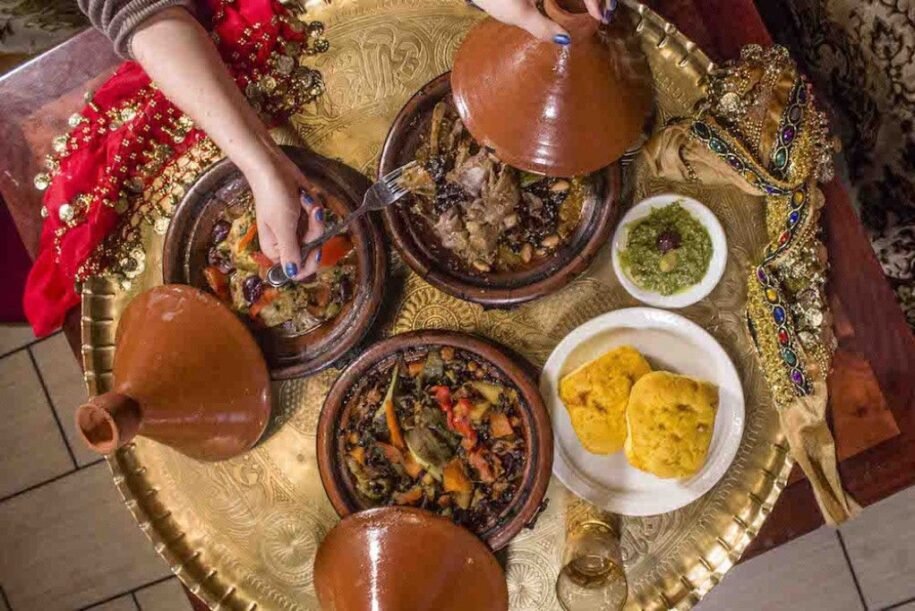Morocco is a land of vibrant colors, rich traditions, and unforgettable flavors. Among its many treasures, Moroccan cuisine stands out as a tantalizing blend of Mediterranean freshness, Eastern Arab influences, and Berber heritage. Its dishes reflect the country’s diverse landscapes, from the lush coastal plains to the rugged Atlas Mountains and the vast Sahara Desert. Moroccan food is more than a meal—it’s an experience steeped in history and culture, where every bite tells a story.
This journey takes you through the heart of Moroccan cuisine, exploring its ingredients, cooking techniques, and signature dishes that have made it a favorite among food enthusiasts worldwide.
A Quick Overview of Moroccan Food
Moroccan meals are as much about presentation and hospitality as they are about taste. A typical meal begins with an array of appetizers, often served with flatbread, olives, and sometimes a dollop of harissa or olive oil. These small plates may include creamy eggplant and pepper dips, grated carrots dressed with orange juice, or chickpea purees. A favorite starter is the “Salad Marocaine,” a colorful combination of tomatoes, cucumbers, onions, potatoes, beets, and olives.
As the meal progresses, the main courses take center stage. These are hearty, flavorful, and designed to be shared. Dishes range from aromatic lamb skewers to elaborate tajines and the iconic couscous, each bursting with layers of flavor. To end the meal, desserts like cinnamon-dusted oranges, fresh fruits, or honey-soaked pastries bring a touch of sweetness.
The Secret to Moroccan Flavors
Moroccan cuisine owes its distinct taste to the creative use of spices and herbs. Cumin, cinnamon, ginger, saffron, and coriander are staples in Moroccan kitchens, each adding depth and character to the dishes. One standout spice blend is Ras el Hanout, a complex mix of over 30 spices crafted by local spice vendors. This versatile blend enhances many Moroccan dishes and is a cherished souvenir for visitors.
Herbs like mint, coriander, flat parsley, and thyme play an equally important role, often added fresh to stews, soups, and salads. Moroccan cooking also highlights the use of premium olive oil and the coveted argan oil, both adding a unique richness to the cuisine.
A Closer Look at Moroccan Dishes
When visiting Morocco, there are certain must-try dishes that offer a true taste of the country’s rich culinary traditions. Below are some of the most beloved and iconic Moroccan dishes that should be at the top of your culinary bucket list.
Tajine: A Culinary Art in Clay
When most people think of Moroccan food, they immediately think of Tajine, a dish that is as much about the pot as it is about the food. The Tajine pot, a cone-shaped clay vessel, traps steam and ensures that the ingredients cook in their juices, creating rich and aromatic flavors. The classic Tajine combines marinated meat or fish with seasonal vegetables, fruits, and herbs. Popular variations include:
Fish Tajine – Often cooked with fresh vegetables and aromatic spices.
Chicken Tajine with preserved lemons and olives
Lamb Tajine with prunes and almonds
Couscous: Morocco’s National Dish
Couscous, a dish with Berber roots, is arguably the most iconic dish in Morocco. Made of steamed semolina, Couscous is typically served with a stew of lamb, chicken, or vegetables, and topped with a blend of spices. Traditionally, families serve Couscous on Fridays, following prayers.
The preparation of Couscous involves steaming the semolina and serving it in a mountainous pile with vegetables and meat. In some versions, sugar, butter, and dried fruits are added, making it a sweet dish. Traditionally, Moroccans eat Couscous using only their right hand, shaping small balls of couscous, vegetables, and meat before pushing them into their mouths with their thumb.
Brochettes: Grilled Skewers of Meat
For street food lovers, Brochettes are the perfect option. These grilled skewers of tender meat, often lamb or chicken, are a favorite Moroccan snack. They are usually paired with a fresh Salade Marocaine and bread (Khubz). Perfect for a quick bite or an afternoon snack, these skewers are grilled to perfection and full of flavor.
Kefta: Moroccan Meatballs
Kefta, a Moroccan delicacy, consists of spiced meatballs or sausages. Made from minced lamb, beef, or even sardines, the Kefta is either grilled or seared in oil. It’s a dish widely spread across the Maghreb and Middle Eastern cuisines, but each region has its variations. Kefta is often served with flatbread and is enjoyed for breakfast, lunch, or dinner.
Merguez: Spicy Lamb Sausages
Merguez sausages are another popular Moroccan street food. Grilled or fried, these spicy lamb sausages are served in flatbread, creating a perfect sandwich. These sausages are widely available at food stalls and are enjoyed by both locals and tourists alike. Merguez is best served with a side of salad or fries and a mint tea to balance the heat.
Mechoui: The Slow-Roasted Lamb
Mechoui is a festive dish traditionally prepared during the Feast of Sacrifice or the New Year. It involves slow-roasting a whole lamb or mutton in a clay oven. The meat is seasoned with garlic, spices, and butter, and then cooked for several hours, producing tender, flavorful meat that falls off the bone. Often served at large family gatherings, Mechoui is a dish that highlights the Moroccan love for slow-cooked meals.
Harira: A Nourishing Staple
Harira, a hearty soup made with tomatoes, lentils, chickpeas, and spices, is a staple during Ramadan but is enjoyed year-round. This nourishing dish is often served with fresh bread or sweet pastries, making it a comforting choice for any time of day.
Briouats: Savory or Sweet Delights
For a quick snack or appetizer, try Briouats, a type of pastry that comes in triangular or spring-roll shapes. These pastries are stuffed with a variety of fillings, such as minced lamb, vegetables, or cheese, and are typically fried to a crisp golden brown. For those with a sweet tooth, there are also Briouats filled with almonds and drenched in honey. These treats are especially popular during Ramadan, served as part of the iftar meal.
Moroccan Desserts: Sweet Temptations
After a filling Moroccan meal, there’s always room for a sweet treat. Some of the most popular Moroccan desserts include fresh fruits, often topped with cinnamon or a sprinkle of sugar, and pastries like Baklava or Kaab el Ghazal. The latter is a sweet almond-filled pastry often shaped into crescent moons.
Orange with Cinnamon: A Simple Delight
One of the simplest but most delicious Moroccan desserts is oranges with cinnamon. This dessert showcases the country’s abundance of fresh citrus fruits, paired with the warm, earthy flavor of cinnamon. It’s often served after a meal to cleanse the palate and offer a refreshing end to the feast.
Moroccan Beverages: Tea and More
When it comes to drinks, Morocco is famous for its mint tea, also known as Maghrebi mint tea. This sweet green tea infusion is often prepared with fresh mint leaves and sugar and is served in small glasses. Tea is an integral part of Moroccan culture and is consumed throughout the day, symbolizing hospitality and friendship. In fact, you’ll likely find yourself invited to share a cup of tea with locals wherever you go.
Beyond Moroccan Food: The Culinary Experience
Eating in Morocco is about more than just food—it’s about connection and culture. Meals are often shared communally, with dishes placed at the center of the table for everyone to enjoy. The act of eating with your hands, particularly when enjoying couscous, adds a tactile dimension to the experience.
Markets and spice shops are essential stops for anyone interested in Moroccan cuisine. These bustling spaces offer a sensory overload of colors, aromas, and flavors, showcasing the ingredients that make Moroccan food so special.
Conclusion: Traditional dishes in Morocco
Morocco’s culinary scene is a testament to the country’s rich history and cultural diversity. From the comforting warmth of a slow-cooked tajine to the refreshing simplicity of a salad marinated in orange juice, every dish tells a story of tradition, innovation, and love for food. Whether you’re exploring street food in Marrakech or savoring a home-cooked meal in a rural village, the flavors of Morocco are sure to leave an indelible mark on your palate and your heart.
Ready to explore Morocco’s culinary treasures? Book your Private Morocco Tour today and indulge in the exotic flavors of this beautiful country!


Leave a Reply